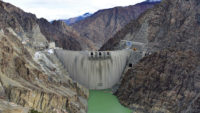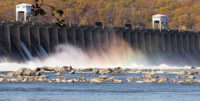Destructive flooding in northeastern Libya, caused by torrential rains from a rare Mediterranean hurricane Sept. 10 and the related collapse of two dams outside the coastal city of Derna, killed more than 11,000 people, according to estimates. The International Federation of Red Cross and Red Crescent Societies issued an emergency appeal Sept. 13 for more funds and assistance to scale up relief efforts.
“This disaster was violent and brutal,” said Yann Fridez, head of the Federation's Libya delegation, in a statement. “A wave 7 meters high wiped out buildings and washed infrastructure into the sea. Now family members are missing, dead bodies are washing back up on shore, and homes are destroyed. The city faces immense emotional trauma.”
Rescue and response teams currently are burying the dead, providing emergency health care and shelter to survivors, as well as basic water and sanitation services. Federation officials described the situation on the ground as chaotic, with no internet access, electrical wires down, and access to key areas blocked by degraded or destroyed roads. Adding to the challenge for emergency responders is navigating unexploded ordnance and abandoned munitions in Derna.
Dam Failures
Al Jazeera reports that some 30 million cu meters of water—the equivalent of 12,000 Olympic size pools—were released when the two dams roughly 13 km outside of Derna collapsed.
While the cause of the failures is still not known, some experts suggest that the two aging, clay-core embankment dams were overwhelmed by the amount of water brought by Storm Daniel, which pummeled Greece with more than 20 in. of rain the first week of September before picking up strength as it moved through the Mediterranean. The dams were built in the 1970s.
“Poor maintenance and management over the intervening years may have contributed to the problem, but the most likely scenario is that the inflow over the last weekend due to Storm Daniel exceeded the spillway capacity at the upstream Al-Bilad Dam, whether due to the spillway capacity being inadequate, or a blockage of some sort in the spillway,” said Quentin Shaw, a director at ARQ Consulting Engineers and a vice president of the International Commission on Dams, in an email. This excess water led to the breaching of both dams and their eventual collapse, he added.
Officials in Libya, which has been besieged by political unrest since the assassination of Muammar Gaddafi in 2011, have appealed for international assistance. President Joe Biden said in a statement Sept. 12 that the U.S. would send emergency funds to relief organizations and coordinate with Libyan authorities to provide additional support.
Shaw noted that governments typically should have an emergency preparedness plan with warning and evacuation protocols. “It would seem that nothing of that nature existed, or was rolled out, for the Derna dams, and no warning after the dam failures and/or of the impending arrival of a dam-break flood was given,” he said.
Libya’s National Meteorological Centre has said it issued early warnings about the storm 72 hours before it landed, notifying government authorities by emails and urging people to take more care and caution, and also urging them to take preventive measures.
But Hannah Cloke, professor of hydrology at the University of Reading in the U.K., said in a statement that failures in the early warning system seem to have occurred. “To be effective, flood forecasting systems need good data on forecast rainfall and river levels, a network of well-maintained measuring instruments on the ground, and a clear plan to get people out of harm's way,” she said. “Libya has far from the ideal economic or political conditions to provide adequate flood early warning systems.”
The text of this story was corrected on Oct. 3 to reflect the proper number of Olympic-sized swimming pools that Al Jazeera had suggested were equivalent to the amount of water released by the dam collapse.



_in_Conowingo_Station_Cecil_County_Maryland.jpg?height=200&t=1671739394&width=200)


Post a comment to this article
Report Abusive Comment